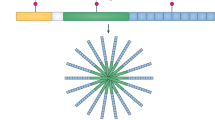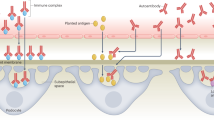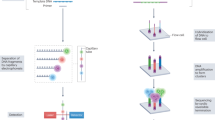Abstract
Research into the pathogenesis of the spondyloarthropathies has examined the role of HLA-B27 and other genes in susceptibility to these diseases. Novel characteristics of HLA-B27 have been discovered, which have allowed hypotheses for an influence of HLA-B27 on disease to be developed that do not reflect its ability to present arthritogenic peptides to CD8+ T cells. Although a role for CD8+ T cells has not been excluded, they are not required in the HLA-B27 transgenic rat model, and do not dominate at sites of disease in humans. Studies have also focused on the consequences of the (rather inefficient) intracellular folding of the HLA-B27 heavy chain, the ability of cells to deal with intracellular infection, and their expression of unusual forms of HLA-B27 on cell surfaces (including free heavy chains and dimers). Unusual surface forms of HLA-B27 interact with a different set of receptors from those that recognize conventional class I MHC molecules and thus can be implicated in driving inflammatory responses. Additional candidate susceptibility genes are being identified, either using gene-targeting technology in mice, or genomic screening approaches in humans. In several cases, as with HLA-B27, the evidence suggests that these genes influence the response of the host to bacteria, including pathogens and commensal organisms of the skin and gastrointestinal tract. The concept that spondyloarthropathies are the result of interactions between susceptibility genes, bacteria and the immune system remains a useful model for the pathogenesis of these diseases.
Key Points
-
HLA-B27 proteins possess several unusual properties that might contribute to susceptibility to spondyloarthropathies (SpAs)
-
Several non-HLA-B27 genes also influence susceptibility to SpAs
-
The influence of susceptibility genes is often connected with interactions with pathogenic or commensal bacteria
-
A better understanding of the pathogenesis of SpA is urgently required; despite notable advances in treatment no curative therapy is currently available
This is a preview of subscription content, access via your institution
Access options
Subscribe to this journal
Receive 12 print issues and online access
$209.00 per year
only $17.42 per issue
Buy this article
- Purchase on Springer Link
- Instant access to full article PDF
Prices may be subject to local taxes which are calculated during checkout


Similar content being viewed by others
References
Sims AM et al. (2004) Genetic susceptibility to ankylosing spondylitis. Curr Mol Med 4: 13–20
Laval SH et al. (2001) Whole-genome screening in ankylosing spondylitis: evidence of non-MHC genetic-susceptibility loci. Am J Hum Genet 68: 918–926
Gaston JS (2001) Infection in the aetiology of spondyloarthropathies. Clin Med 1: 104–107
Gaston JSH (1998) Role of T-cells in the development of arthritis. Clin Sci 95: 19–31
Gaston JSH (2000) Immunological basis of Chlamydia induced reactive arthritis. Sex Transm Infect 76: 156–161
Colbert RA (2004) The immunobiology of HLA-B27: variations on a theme. Curr Mol Med 4: 21–30
Mear JP et al. (1999) Misfolding of HLA-B27 as a result of its B pocket suggests a novel mechanism for its role in susceptibility to spondyloarthropathies. J Immunol 163: 6665–6670
Turner MJ et al. (2005) HLA-B27 misfolding in transgenic rats is associated with activation of the unfolded protein response. J Immunol 175: 2438–2448
Gu J et al. (2002) Clues to pathogenesis of spondyloarthropathy derived from synovial fluid mononuclear cell gene expression profiles. J Rheumatol 29: 2159–2164
Penttinen MA et al. (2002) HLA-B27 modulates nuclear factor kappa B activation in human monocytic cells exposed to lipopolysaccharide. Arthritis Rheum 46: 2172–2180
Goodall JC et al. Does HLA-B27 influence the monocyte inflammatory response to LPS? Rheumatology, in press
Peh CA et al. (1988) HLA-B27-restricted antigen presentation in the absence of tapasin reveals polymorphism in mechanisms of HLA class I peptide loading. Immunity 8: 531–542
Barnden MJ et al. (2000) Tapasin-mediated retention and optimization of peptide ligands during the assembly of class I molecules. J Immunol 165: 322–330
Williams AP et al. (2002) Optimization of the MHC class I peptide cargo is dependent on tapasin. Immunity 16: 509–520
Park B et al. (2003) A single polymorphic residue within the peptide-binding cleft of MHC class I molecules determines spectrum of tapasin dependence. J Immunol 170: 961–968
Goodall JC et al. (2006) Spondylarthritis-associated and non-spondylarthritis-associated B27 subtypes differ in their dependence upon tapasin for surface expression and their incorporation into the peptide loading complex. Arthritis Rheum 54: 138–147
Fiorillo MT et al. (1998) The naturally occurring polymorphism Asp116→His116, differentiating the ankylosing spondylitis-associated HLA-B*2705 from the non-associated HLA-B*2709 subtype, influences peptide-specific CD8 T cell recognition. Eur J Immunol 28: 2508–2516
Nasution AR et al. (1997) HLA-B27 subtypes positively and negatively associated with spondyloarthropathy. J Rheumatol 24: 1111–1114
Vazquez MN and Lopez de Castro JA (2005) Similar cell surface expression of β2-microglobulin-free heavy chains by HLA-B27 subtypes differentially associated with ankylosing spondylitis. Arthritis Rheum 52: 3290–3299
Bennett EM et al. (1999) Cutting edge: adenovirus E19 has two mechanisms for affecting class I MHC expression. J Immunol 162: 5049–5052
Park B et al. (2004) Human cytomegalovirus inhibits tapasin-dependent peptide loading and optimization of the MHC class I peptide cargo for immune evasion. Immunity 20: 71–85
Purcell AW et al. (2001) Quantitative and qualitative influences of tapasin on the class I peptide repertoire. J Immunol 166: 1016–1027
Allen RL et al. (1999) Cutting edge: HLA-B27 can form a novel beta 2-microglobulin-free heavy chain homodimer structure. J Immunol 162: 5045–5048
Kollnberger S et al. (2002) Cell-surface expression and immune receptor recognition of HLA-B27 homodimers. Arthritis Rheum 46: 2972–2982
Kollnberger S et al. (2004) HLA-B27 heavy chain homodimers are expressed in HLA-B27 transgenic rodent models of spondyloarthritis and are ligands for paired Ig-like receptors. J Immunol 173: 1699–1710
Bird LA et al. (2003) Lymphoblastoid cells express HLA-B27 homodimers both intracellularly and at the cell surface following endosomal recycling. Eur J Immunol 33: 748–759
Allen RL et al. (2001) Cutting edge: leukocyte receptor complex-encoded immunomodulatory receptors show differing specificity for alternative HLA-B27 structures. J Immunol 167: 5543–5547
Allen RL and Trowsdale J (2004) Recognition of classical and heavy chain forms of HLA-B27 by leukocyte receptors. Curr Mol Med 4: 59–65
Boyle LH et al. (2001) The recognition of HLA-B27 by human CD4+ T lymphocytes. J Immunol 167: 2619–2624
Boyle LH et al. (2004) The recognition of abnormal forms of HLA-B27 by CD4+ T cells. Curr Mol Med 4: 51–58
Zhou M et al. (1998) The specificity of peptides bound to human histocompatibility leukocyte antigen (HLA)-B27 influences the prevalence of arthritis in HLA-B27 transgenic rats. J Exp Med 188: 877–886
Tran TM et al. (2006) Additional human beta(2)-microglobulin curbs HLA-B27 misfolding and promotes arthritis and spondylitis without colitis in male HLA-B27-transgenic rats. Arthritis Rheum 54: 1317–1327
Hulsmeyer M et al. (2004) Dual HLA-B27 subtype-dependent conformation of a self-peptide. J Exp Med 199: 271–281
Fiorillo MT et al. (2000) CD8+ T-cell autoreactivity to an HLA-B27-restricted self-epitope correlates with ankylosing spondylitis. J Clin Invest 106: 47–53
Hugot JP et al. (2001) Association of NOD2 leucine-rich repeat variants with susceptibility to Crohn's disease. Nature 411: 599–603
Ogura Y et al. (2001) A frameshift mutation in NOD2 associated with susceptibility to Crohn's disease. Nature 411: 603–606
Rahman P et al. (2003) CARD15: a pleiotropic autoimmune gene that confers susceptibility to psoriatic arthritis. Am J Hum Genet 73: 677–681
Eckmann L and Karin M (2005) NOD2 and Crohn's disease: loss or gain of function? Immunity 22: 661–667
Watanabe T et al. (2004) NOD2 is a negative regulator of Toll-like receptor 2-mediated T helper type 1 responses. Nat Immunol 5: 800–808
Kobayashi KS et al. (2005) Nod2-dependent regulation of innate and adaptive immunity in the intestinal tract. Science 307: 731–734
van Heel DA et al. (2005) Muramyl dipeptide and Toll-like receptor sensitivity in NOD2-associated Crohn's disease. Lancet 365: 1794–1796
Ritchlin CT (2005) Pathogenesis of psoriatic arthritis. Curr Opin Rheumatol 17: 406–412
Zenz R et al. (2005) Psoriasis-like skin disease and arthritis caused by inducible epidermal deletion of Jun proteins. Nature 437: 369–375
Hofmann MA et al. (1999) RAGE mediates a novel proinflammatory axis: a central cell surface receptor for S100/calgranulin polypeptides. Cell 97: 889–901
Sano S et al. (2005) Stat3 links activated keratinocytes and immunocytes required for development of psoriasis in a novel transgenic mouse model. Nat Med 11: 43–49
Mease PJ and Antoni CE (2005) Psoriatic arthritis treatment: biological response modifiers. Ann Rheum Dis 64 (Suppl 2): ii78–ii82
Mease P (2004) TNF alpha therapy in psoriatic arthritis and psoriasis. Ann Rheum Dis 63: 755–758
Taurog JD et al. (1994) The germfree state prevents development of gut and joint inflammatory disease in HLA-B27 transgenic rats. J Exp Med 180: 2359–2364
Rath HC et al. (1996) Normal luminal bacteria, especially Bacteroides species, mediate chronic colitis, gastritis, and arthritis in HLA-B27/human β2 microglobulin transgenic rats. J Clin Invest 98: 945–953
Lories RJ et al. (2005) Modulation of bone morphogenetic protein signaling inhibits the onset and progression of ankylosing enthesitis. J Clin Invest 115: 1571–1579
McGonagle D et al. (1998) Classification of inflammatory arthritis by enthesitis. Lancet 352: 1137–1140
Laloux L et al. (2001) Immunohistological study of entheses in spondyloarthropathies: comparison in rheumatoid arthritis and osteoarthritis. Ann Rheum Dis 60: 316–321
Veale D et al. (1993) Reduced synovial membrane macrophage numbers, ELAM-1 expression, and lining layer hyperplasia in psoriatic arthritis as compared with rheumatoid arthritis. Arthritis Rheum 36: 893–900
Veale DJ et al. (2005) Immunopathology of psoriasis and psoriatic arthritis. Ann Rheum Dis 64 (Suppl 2): ii26–ii29
Smeets TJM et al. (1998) Analysis of the cellular infiltrates and expression of cytokines in synovial tissue from patients with rheumatoid arthritis and reactive arthritis. J Pathol 186: 75–81
Braun J et al. (1995) Use of immunohistologic and in situ hybridization techniques in the examination of sacroiliac joint biopsy specimens from patients with ankylosing spondylitis. Arthritis Rheum 38: 499–505
Bollow M et al. (2000) Quantitative analyses of sacroiliac biopsies in spondyloarthropathies: T cells and macrophages predominate in early and active sacroiliitis—cellularity correlates with the degree of enhancement detected by magnetic resonance imaging. Ann Rheum Dis 59: 135–140
Goedkoop AY et al. (2004) Early effects of tumour necrosis factor alpha blockade on skin and synovial tissue in patients with active psoriasis and psoriatic arthritis. Ann Rheum Dis 63: 769–773
Author information
Authors and Affiliations
Corresponding author
Ethics declarations
Competing interests
The author declares no competing financial interests.
Rights and permissions
About this article
Cite this article
Gaston, H. Mechanisms of Disease: the immunopathogenesis of spondyloarthropathies. Nat Rev Rheumatol 2, 383–392 (2006). https://doi.org/10.1038/ncprheum0219
Received:
Accepted:
Issue Date:
DOI: https://doi.org/10.1038/ncprheum0219
This article is cited by
-
An HLA-B27 Homodimer Specific Antibody Recognizes a Discontinuous Mixed-Disulfide Epitope as Identified by Affinity-Mass Spectrometry
Journal of the American Society for Mass Spectrometry (2016)
-
Short peptide sequence identity between human viruses and HLA-B27-binding human ‘self’ peptides
Theory in Biosciences (2014)



